![]()
![]() (Sanskrit:
(Sanskrit: ![]() ) refers both to the abstract rhythmic system found in the music theory of the Indian subcontinent and to specific metric patterns. Repeated cyclically, these metric patterns provide a stable framework for composition and performance. Their structural properties are marked by an ancient system of hand gestures which subdivide the cycle into segments of equal or unequal length and create an internal rhythmic hierarchy.
) refers both to the abstract rhythmic system found in the music theory of the Indian subcontinent and to specific metric patterns. Repeated cyclically, these metric patterns provide a stable framework for composition and performance. Their structural properties are marked by an ancient system of hand gestures which subdivide the cycle into segments of equal or unequal length and create an internal rhythmic hierarchy. 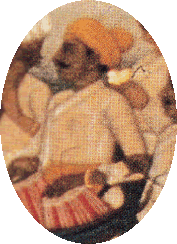 Performers and audience members are often seen gesturing with claps and waves: the clap is produced by slapping the right palm down onto the left, or onto the thigh; the wave is, by contrast, a silent gesture in which the right hand moves away and turns palm-upwards, ending with a small bounce akin to a conductor’s beat that effectively marks the absence of a clap. By convention, claps are notated with a sequence of numbers, and waves are designated by a zero (0). However, the clap marking the all-important beginning of a cycle (sam) is usually accorded an X rather than the number 1.
Performers and audience members are often seen gesturing with claps and waves: the clap is produced by slapping the right palm down onto the left, or onto the thigh; the wave is, by contrast, a silent gesture in which the right hand moves away and turns palm-upwards, ending with a small bounce akin to a conductor’s beat that effectively marks the absence of a clap. By convention, claps are notated with a sequence of numbers, and waves are designated by a zero (0). However, the clap marking the all-important beginning of a cycle (sam) is usually accorded an X rather than the number 1.
The system of gestures is adhered to rigorously in the southern Indian classical system known as Karnatak music, and somewhat less rigorously in the northern Indian classical system known as Hindustani music. The modern performance traditions that now dominate Hindustani music are rooted in developments that occurred in the eighteenth and nineteenth centuries: ![]() singing (see Bonnie Wade’s comprehensive discussion of this genre, 1984), and the
singing (see Bonnie Wade’s comprehensive discussion of this genre, 1984), and the ![]() and
and ![]() instrumental traditions (see Allyn Miner’s seminal work, 1993). These are now routinely accompanied by the tabla drum pair,
instrumental traditions (see Allyn Miner’s seminal work, 1993). These are now routinely accompanied by the tabla drum pair,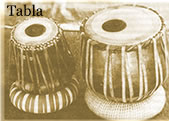 whose provenance can also be traced to the early eighteenth century. However, the tabla was originally used to accompany the lighter songs and dances of the
whose provenance can also be traced to the early eighteenth century. However, the tabla was originally used to accompany the lighter songs and dances of the ![]() (courtesans), and it gradually spread and rose in importance until it finally supplanted the older and more austere
(courtesans), and it gradually spread and rose in importance until it finally supplanted the older and more austere ![]() (double-headed barrel drum) as the pre-eminent drum of Hindustani classical music by the end of the nineteenth century. It is my contention that the main reason the clapping gestures are less rigorously adhered to in this music is that the metric-rhythmic system of the upstart tabla is in many ways incongruent with the older system of
(double-headed barrel drum) as the pre-eminent drum of Hindustani classical music by the end of the nineteenth century. It is my contention that the main reason the clapping gestures are less rigorously adhered to in this music is that the metric-rhythmic system of the upstart tabla is in many ways incongruent with the older system of ![]() that is preserved in the
that is preserved in the ![]() drumming tradition. By contrast, the tabla’s drumming patterns are largely indebted to folk, light, and semi-classical rhythms and meters that follow different rules. I have characterized these rhythms as grooves, by which I mean regularly repeating accentual patterns rooted in bodily movement (i.e. dance).
drumming tradition. By contrast, the tabla’s drumming patterns are largely indebted to folk, light, and semi-classical rhythms and meters that follow different rules. I have characterized these rhythms as grooves, by which I mean regularly repeating accentual patterns rooted in bodily movement (i.e. dance).
Modern Indian scholars and performers of Hindustani traditions, particularly those who have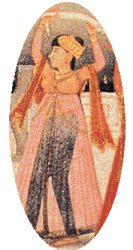 come to it as a vocation and not as an hereditary occupational specialization, have often promoted a revisionist interpretation of the music: one that emphasizes its ancient Hindu roots, its spiritual and intellectual properties, and its solid theoretical sophistication. The remarkable yet unpublished dissertation of Rebecca Stewart (1974) was the first to challenge this view by investigating
come to it as a vocation and not as an hereditary occupational specialization, have often promoted a revisionist interpretation of the music: one that emphasizes its ancient Hindu roots, its spiritual and intellectual properties, and its solid theoretical sophistication. The remarkable yet unpublished dissertation of Rebecca Stewart (1974) was the first to challenge this view by investigating ![]() : the fixed accompanimental patterns played by the tabla. I intend to build on this work by peeling away some of the layers to expose the true nature of tabla
: the fixed accompanimental patterns played by the tabla. I intend to build on this work by peeling away some of the layers to expose the true nature of tabla ![]() . What is revealed, I think, has implications for the retelling of Hindustani music history.
. What is revealed, I think, has implications for the retelling of Hindustani music history.
![]()
Metric cycles are found in the northern Hindustani system as well as in the southern Karnatak system, but only in the first are they articulated by a fairly fixed series of ![]() , or quasi-onomatopoeic syllables with corresponding drum strokes (e.g.
, or quasi-onomatopoeic syllables with corresponding drum strokes (e.g. ![]() etc.). When repeated cyclically these syllabic/stroke patterns are known as
etc.). When repeated cyclically these syllabic/stroke patterns are known as ![]() , meaning “support”: an appropriate word in view of their essential function as supporting or accompanying patterns. Among traditional (that is, hereditary) Hindustani musicians I have found that the
, meaning “support”: an appropriate word in view of their essential function as supporting or accompanying patterns. Among traditional (that is, hereditary) Hindustani musicians I have found that the ![]() is the primary signifier of a
is the primary signifier of a ![]() , not the clapping pattern. Since no equivalent fixed pattern exists in Karnatak music the gestures dominate there, often to the extent that a knowledgeable audience joins the musicians in unerring sequences of claps, waves, and finger counts. This is rarely the case with a Hindustani concert. The difference, then, is that Hindustani meter is an internal notion that is externalized by the
, not the clapping pattern. Since no equivalent fixed pattern exists in Karnatak music the gestures dominate there, often to the extent that a knowledgeable audience joins the musicians in unerring sequences of claps, waves, and finger counts. This is rarely the case with a Hindustani concert. The difference, then, is that Hindustani meter is an internal notion that is externalized by the ![]() while Karnatak meter is an internal notion that is externalized by clapping.
while Karnatak meter is an internal notion that is externalized by clapping.
The notable exception in Hindustani music is ![]() , which retains much of its gestural language: in this older, and now much rarer, genre accompanied by the
, which retains much of its gestural language: in this older, and now much rarer, genre accompanied by the ![]() there was almost certainly no concept equivalent to
there was almost certainly no concept equivalent to ![]() , and the early twentieth-century scholar V.N. Bhatkhande’s invented term
, and the early twentieth-century scholar V.N. Bhatkhande’s invented term ![]() has no currency (I have never heard it used). As is the case in Karnatak music, Hindustani
has no currency (I have never heard it used). As is the case in Karnatak music, Hindustani ![]() singers and
singers and ![]() drummers perform compositions and improvisations simultaneously, and so rather than repeated cycles of fixed
drummers perform compositions and improvisations simultaneously, and so rather than repeated cycles of fixed ![]() patterns it is the hand gestures that provide (i.e. externalize) the necessary temporal markers. It seems likely that both the concept and the practice of
patterns it is the hand gestures that provide (i.e. externalize) the necessary temporal markers. It seems likely that both the concept and the practice of ![]() , if not the term, were borrowed by the
, if not the term, were borrowed by the ![]() in recent times.
in recent times. ![]() patterns (see Figure 1) associated with traditional
patterns (see Figure 1) associated with traditional ![]()
![]() (e.g.
(e.g. ![]() ,
,![]() ,
, ![]() )1 are really adaptations or extensions of a short
)1 are really adaptations or extensions of a short ![]() (composed sequence) that ends with a standard cadential figure
(composed sequence) that ends with a standard cadential figure ![]() . As markers of the internal structure of the
. As markers of the internal structure of the ![]() these patterns are inconsistent, otherwise the position of the claps (X, 2, 3 etc.) and waves (0) would have more in common. (Note, in particular, that
these patterns are inconsistent, otherwise the position of the claps (X, 2, 3 etc.) and waves (0) would have more in common. (Note, in particular, that ![]() is marked by a clap and a wave in
is marked by a clap and a wave in![]() and by two claps in
and by two claps in ![]() ). I would like to say that these
). I would like to say that these ![]()
![]() patterns qua
patterns qua ![]() have probably become fixed by a mixture of habit and the scholarly (and/or modern didactic) practice of writing them down, but more evidence is needed.
have probably become fixed by a mixture of habit and the scholarly (and/or modern didactic) practice of writing them down, but more evidence is needed.
![]()
![]() are thought to be linked to Sanskrit verse whose agogic organization is essentially an additive, or quantitative, system of short (S) and long (L) syllables: the short, marked as a clap, is half the duration of the long, marked by a clap plus a wave. In this system, though, each clap and wave in
are thought to be linked to Sanskrit verse whose agogic organization is essentially an additive, or quantitative, system of short (S) and long (L) syllables: the short, marked as a clap, is half the duration of the long, marked by a clap plus a wave. In this system, though, each clap and wave in ![]() and
and ![]() is given its own
is given its own ![]() , or subdivision.
, or subdivision. ![]() is clapped and played as 3+2+2, but is rationalized as 2+1+2+2, or LSLL.
is clapped and played as 3+2+2, but is rationalized as 2+1+2+2, or LSLL. ![]() (or
(or ![]()
![]() , a fourteen-count2
, a fourteen-count2 ![]() whose constituent
whose constituent ![]() and structure are hotly debated, is an exception that can be explained by the fact that it was borrowed from the folk music of the Mathura region (the homeland of Lord Krishna).
and structure are hotly debated, is an exception that can be explained by the fact that it was borrowed from the folk music of the Mathura region (the homeland of Lord Krishna).
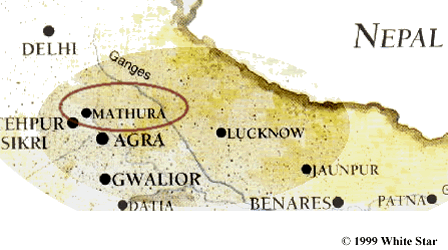
Scholars continue to puzzle over the incongruities (see Figure 2) of the Hindustani ![]() system. Why does seven-count
system. Why does seven-count ![]() begin with a wave instead of a clap? Can the
begin with a wave instead of a clap? Can the ![]() in
in ![]() also be the
also be the ![]() ? Why does a “
? Why does a “![]() ” occur on the ninth count in
” occur on the ninth count in ![]() when the structure suggests a “
when the structure suggests a “![]() ,” and, conversely, why is there a “
,” and, conversely, why is there a “![]() ” on the thirteenth count when one expects a “
” on the thirteenth count when one expects a “![]() “? (See Erdman 23.) Why does the
“? (See Erdman 23.) Why does the ![]() of twelve-count
of twelve-count ![]() seemingly defy the internal divisional structure of the
seemingly defy the internal divisional structure of the ![]() ? And why does
? And why does ![]() have two
have two ![]() ? As Joan Erdman found (ibid.), there is little to be gained from asking traditional musicians since they tend to accept uncritically the knowledge they inherit from their forefathers. Among writers it is common to offer the ready excuse that
? As Joan Erdman found (ibid.), there is little to be gained from asking traditional musicians since they tend to accept uncritically the knowledge they inherit from their forefathers. Among writers it is common to offer the ready excuse that ![]() (theory) simply lags behind
(theory) simply lags behind ![]() (practice) (Ramanathan 15). But most modern theory, in my view, suffers from an inability to problematize Hindustani
(practice) (Ramanathan 15). But most modern theory, in my view, suffers from an inability to problematize Hindustani ![]() and an unwillingness to relate it to the sociocultural milieu in which this system emerged.
and an unwillingness to relate it to the sociocultural milieu in which this system emerged.
The answer to these ![]() puzzles at the broadest level, I would suggest, is that Hindustani
puzzles at the broadest level, I would suggest, is that Hindustani ![]() has developed organically from the rhythmic characteristics of a range of folk, popular, and semi-classical genres, and it simply does not fit the classical theoretical model for rhythm and meter. Effectively, the rhythms of these other genres, or grooves as I like to characterize them, have largely been superimposed on existing metrical frameworks derived from Sanskrit verse. This idea is not new: Rebecca Stewart has made a splendid case for this view, and Peter Manuel’s excellent work on the
has developed organically from the rhythmic characteristics of a range of folk, popular, and semi-classical genres, and it simply does not fit the classical theoretical model for rhythm and meter. Effectively, the rhythms of these other genres, or grooves as I like to characterize them, have largely been superimposed on existing metrical frameworks derived from Sanskrit verse. This idea is not new: Rebecca Stewart has made a splendid case for this view, and Peter Manuel’s excellent work on the ![]() has provided evidence that this most influential of genres used folk-derived rhythmic structures.
has provided evidence that this most influential of genres used folk-derived rhythmic structures.

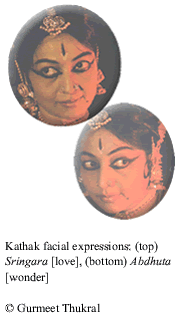 ms and styles of music that we know today (see Kippen 16-26). In Delhi courtesans had specialized in performing the light and popular Urdu
ms and styles of music that we know today (see Kippen 16-26). In Delhi courtesans had specialized in performing the light and popular Urdu
Structural evidence suggests few differences between ![]() of eight and sixteen counts (see Figure 6). In essence they all move in pitch from low to high, or from
of eight and sixteen counts (see Figure 6). In essence they all move in pitch from low to high, or from![]() (full) to
(full) to ![]() (empty), and back again. The quality of fullness is conveyed by the presence of the bass drum, which is represented by voiced syllables such as the phonemes
(empty), and back again. The quality of fullness is conveyed by the presence of the bass drum, which is represented by voiced syllables such as the phonemes ![]() and
and ![]() ; emptiness is suggested by the absence of the bass, and the corresponding unvoiced syllables such as
; emptiness is suggested by the absence of the bass, and the corresponding unvoiced syllables such as ![]() and
and ![]() . First, these are not additive structures but rather divisive, based on their internal hierarchy: all of these sixteen-count
. First, these are not additive structures but rather divisive, based on their internal hierarchy: all of these sixteen-count ![]() could be, and indeed often are, counted as eight or four beats, and the eight-count varieties as four or two beats. Second, these are not quantitative structures but rather qualitative, based on the means they use to realize this: their variable pitch, stress, and timbral qualities can be seen to follow almost identical patterns of organization, which I have tried to show by vertical alignment. One notes the
could be, and indeed often are, counted as eight or four beats, and the eight-count varieties as four or two beats. Second, these are not quantitative structures but rather qualitative, based on the means they use to realize this: their variable pitch, stress, and timbral qualities can be seen to follow almost identical patterns of organization, which I have tried to show by vertical alignment. One notes the ![]() -oriented changes in pitch, a strategy that highlights the tendency for the all-important
-oriented changes in pitch, a strategy that highlights the tendency for the all-important ![]() (the only surviving Arabic/Persian term among Sanskrit ones) to fall halfway through the patterns. When conceived as fours the final
(the only surviving Arabic/Persian term among Sanskrit ones) to fall halfway through the patterns. When conceived as fours the final ![]() prepares the return to
prepares the return to ![]() with a contrasting musical signal. Since greatest contrast is achieved through pitch differentiation, the fourth
with a contrasting musical signal. Since greatest contrast is achieved through pitch differentiation, the fourth ![]() often includes the return of the bass drum. Sometimes, too, contrast is conveyed by density: a cadential flourish of more rapid strokes.
often includes the return of the bass drum. Sometimes, too, contrast is conveyed by density: a cadential flourish of more rapid strokes.
If we observe Figure 6 closely, the folk/popular-derived ![]() and
and ![]() might not look very much alike in all their details, but they do share certain structural properties: they move from
might not look very much alike in all their details, but they do share certain structural properties: they move from ![]() to
to ![]() using sequences of
using sequences of ![]() that are almost identical in their pitch and stress contours. Their similarities become even more apparent when examined in relation to the slower
that are almost identical in their pitch and stress contours. Their similarities become even more apparent when examined in relation to the slower ![]()
![]() is a folk dance from Rajasthan/Punjab) which, it could be argued, combines the cadential features of both the others. In turn,
is a folk dance from Rajasthan/Punjab) which, it could be argued, combines the cadential features of both the others. In turn, ![]() ‘s relationship to the stately
‘s relationship to the stately ![]() (a hill fortress in the Punjab) and the primary
(a hill fortress in the Punjab) and the primary ![]()
![]() of
of ![]() (
(![]() is a folk dance from the Punjab hills) is unmistakeable.
is a folk dance from the Punjab hills) is unmistakeable. ![]() and
and ![]() are really varieties of the same thing, but with different rhythmic emphases within the
are really varieties of the same thing, but with different rhythmic emphases within the ![]() : both disguise the pulse, especially when the former is played in the now extinct
: both disguise the pulse, especially when the former is played in the now extinct ![]() (limping) style (see Manuel 149-50). The purpose of such rhythmic ambiguity is probably to accommodate irregular melodic phrasing through sensitive accompaniment, and an important contributor to this is the variable-pitch
(limping) style (see Manuel 149-50). The purpose of such rhythmic ambiguity is probably to accommodate irregular melodic phrasing through sensitive accompaniment, and an important contributor to this is the variable-pitch ![]() stroke (Stewart 368). And thus one sees the connection between these
stroke (Stewart 368). And thus one sees the connection between these ![]() and
and ![]() , which also has the delightful name of “the donkey’s tail
, which also has the delightful name of “the donkey’s tail ![]() “:
“:![]()
![]() mimics accurately elements of pitch and stress not immediately obvious in the notation.
mimics accurately elements of pitch and stress not immediately obvious in the notation.
The distinctly swinging, lilting ![]()
![]() was one of the direct precursors of
was one of the direct precursors of ![]() , and even Bhatkhande referred to the latter as
, and even Bhatkhande referred to the latter as ![]()
![]() (11). The other was known as
(11). The other was known as ![]()
![]() , or simply
, or simply ![]() , and was notated by Imam in the mid-nineteenth century (190). The name
, and was notated by Imam in the mid-nineteenth century (190). The name ![]() also appeared regularly on early twentieth-century recording labels, in fact much more so than the term
also appeared regularly on early twentieth-century recording labels, in fact much more so than the term ![]() (see Kinnear 1994). Although
(see Kinnear 1994). Although ![]() means “slow”, these early recordings show that its pace was what we would now think of as
means “slow”, these early recordings show that its pace was what we would now think of as ![]() (medium-fast tempo): roughly 200 beats per minute. Recorded tabla accompaniments from this era show a strong tendency to integrate the rhythmic features and stroke patterns of both
(medium-fast tempo): roughly 200 beats per minute. Recorded tabla accompaniments from this era show a strong tendency to integrate the rhythmic features and stroke patterns of both ![]() and
and ![]()
![]() . Fast
. Fast ![]() ‘s indebtedness to
‘s indebtedness to ![]() is undeniable, since it tends to use the recited phrase
is undeniable, since it tends to use the recited phrase ![]() rather than the more cumbersome
rather than the more cumbersome ![]() that is more suitable at slower speeds. Fast
that is more suitable at slower speeds. Fast ![]() also mimics effectively the “
also mimics effectively the “![]() ”
” ![]() (footwork) patterns of the kathak dancer. Fast
(footwork) patterns of the kathak dancer. Fast ![]() is nearly always reverted
is nearly always reverted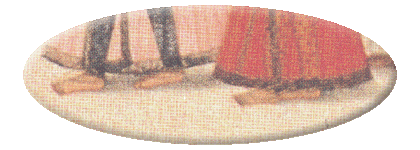 to at the conclusion of a
to at the conclusion of a ![]() where, in the past, the singer and/or members of the dance troupe were expected to dance in quick tempo as the final refrain of the song was repeated.
where, in the past, the singer and/or members of the dance troupe were expected to dance in quick tempo as the final refrain of the song was repeated.
![]() (See Figure 8), which Stewart has characterized as a catch-all term for several classical and folk rhythms (1974: 96), has superimposed a swinging, sesquialtera (or hemiola) pattern onto the agogic framework of
(See Figure 8), which Stewart has characterized as a catch-all term for several classical and folk rhythms (1974: 96), has superimposed a swinging, sesquialtera (or hemiola) pattern onto the agogic framework of ![]() . Its
. Its ![]() suggests that it is really best understood as four groups of three, in keeping with many of the melodic structures created for it; as such, its
suggests that it is really best understood as four groups of three, in keeping with many of the melodic structures created for it; as such, its ![]() /
/![]() structure mirrors that of the 16-count
structure mirrors that of the 16-count ![]() . Argued in this way,
. Argued in this way, ![]() has only one
has only one ![]() ;
; ![]() of course has none, because waves in the agogic system of long and short syllables are not
of course has none, because waves in the agogic system of long and short syllables are not ![]() per se.
per se.
![]() (see Figure 9) has superimposed the popular/folk rhythm from the Northwest Frontier known in India as
(see Figure 9) has superimposed the popular/folk rhythm from the Northwest Frontier known in India as ![]() (but also, sometimes, as the Pakistani-Afghan
(but also, sometimes, as the Pakistani-Afghan ![]() —the term
—the term ![]() is virtually unknown in Pakistan) onto the agogic framework of
is virtually unknown in Pakistan) onto the agogic framework of ![]() probably in very recent times (compare this with Bhatkhande’s version from the early twentieth century). Because of
probably in very recent times (compare this with Bhatkhande’s version from the early twentieth century). Because of ![]() characteristic lilting iambic movement from unstressed to stressed, and from high pitch to low pitch, the ambiguity of
characteristic lilting iambic movement from unstressed to stressed, and from high pitch to low pitch, the ambiguity of ![]()
![]() becomes an issue (is it notated as a
becomes an issue (is it notated as a ![]() or a
or a ![]() ?; and if the latter, then why are the subsequent
?; and if the latter, then why are the subsequent ![]() conventionally-notated as 2 and 3 instead of 1 and 2?).
conventionally-notated as 2 and 3 instead of 1 and 2?).
![]()
I have tried to show how Hindustani music has undergone a sea change in temporal thinking, from agogic Sanskritic verse meter to quite different divisive, qualititive structures marked by fixed patterns that emphasize pitch and stress. Stewart emphasized the likelihood of links with the Arabic system through the ![]() drum tradition, and while I would not dismiss this view, I suspect that ample evidence for a different kind of rhythmic/metrical thinking exists in folk models drawn from the tabla heartland of the North and Northwest of the Indian subcontinent.
drum tradition, and while I would not dismiss this view, I suspect that ample evidence for a different kind of rhythmic/metrical thinking exists in folk models drawn from the tabla heartland of the North and Northwest of the Indian subcontinent. ![]() is a case in point. Such a principle will come as no surprise to scholars of Karnatak music, since the common
is a case in point. Such a principle will come as no surprise to scholars of Karnatak music, since the common ![]() are themselves derived from folk sources, quite unlike the primordial seven
are themselves derived from folk sources, quite unlike the primordial seven ![]() (Nelson 2000: 144). There will be resistance to this view from those who would like to think that the tabla and its
(Nelson 2000: 144). There will be resistance to this view from those who would like to think that the tabla and its ![]() are ancient and neatly accounted for by theory; they will likely feel uncomfortable when challenged with the notion that its rhythms emerged organically from the songs and dances of a category of women modern society now brands as disreputable.
are ancient and neatly accounted for by theory; they will likely feel uncomfortable when challenged with the notion that its rhythms emerged organically from the songs and dances of a category of women modern society now brands as disreputable.
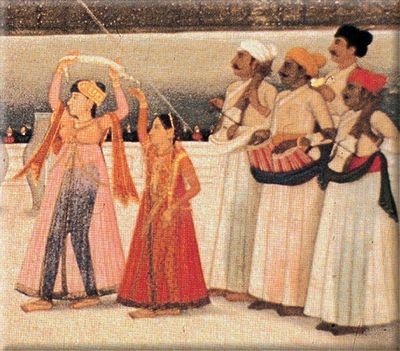
A nautch party (detail from a painting by Mihir Chand, Lucknow ca.1780)
Much more could be said, especially about ![]() like
like ![]() and
and ![]() that, I would argue, have adapted (doubled) 2+3 and 3+4 folk-derived patterns to fit the standard four-
that, I would argue, have adapted (doubled) 2+3 and 3+4 folk-derived patterns to fit the standard four-![]()
![]() /
/![]() format already described for sixteen-count
format already described for sixteen-count ![]() (and probably also for the twelve-count
(and probably also for the twelve-count ![]() ). More could be said also about the modern tendency to drive tempi to the extremes of the continuum, thereby altering the character of many of these
). More could be said also about the modern tendency to drive tempi to the extremes of the continuum, thereby altering the character of many of these ![]() . That is a long story that will be the subject of future studies. One of the casualties for the tabla has been the loss of opportunity to swing and sway with the medium-tempo grooves of the folk, popular and semi-classical
. That is a long story that will be the subject of future studies. One of the casualties for the tabla has been the loss of opportunity to swing and sway with the medium-tempo grooves of the folk, popular and semi-classical ![]() genres: rhythmic realizations of the seductive, sensuous and erotic body and hand movements of the courtesan. Indeed, it mirrors the immense loss to Hindustani music culture of the courtesan herself.
genres: rhythmic realizations of the seductive, sensuous and erotic body and hand movements of the courtesan. Indeed, it mirrors the immense loss to Hindustani music culture of the courtesan herself.
Note:
*The original version of this paper was given at the Toronto 2000: Musical Intersections conference on Thursday, November 2, 2000 as part of a panel on “Cultural Constructions of Time in South Asian Music Cultures.” I wish to thank the organizer, Richard Kent Wolf, other participants David Trasoff and George Ruckert, and discussant Lewis Rowell for their comments and contributions to this stimulating debate. I also wish to thank the Social Science & Humanities Research Council of
Canada for an operating grant (#72005981) that helped make it possible for
me to conduct this research.
![]()
Bhatkhande Sangeet Vidyapith. Prospectus & Syllabus, 1981-1983. Lucknow:
Citizen Press, 1981.
Bhatkhande, Vishnu Narayan. Kramik Pustak Malika. Parts 5 & 6. Hathras: Sangit Karyalaya, 1983.
Bor, Joep. “The Voice of the Sarangi: An Illustrated History of Bowing in India.” National Centre for the Performing Arts, Quarterly Journal, 15.1, 3 (September & December 1986), 16.4 (March 1987).
Erdman, Joan. “The Empty Beat: ![]() as a Sign of Time.” American Journal of Semiotics, 1, 4, pp.21-45, 1982.
as a Sign of Time.” American Journal of Semiotics, 1, 4, pp.21-45, 1982.
Feldman, Jeffrey. The Tabla Legacy of Taranath Rao: Pranava Tala Prajna. Venice, CA: Digitala, 1995.
Imam, Muhammad Karam. ![]() (In Urdu.) Lucknow: Hindustani Press, 1925. [The original MS, lost, dated from the late 1850s or early 1860s.]
(In Urdu.) Lucknow: Hindustani Press, 1925. [The original MS, lost, dated from the late 1850s or early 1860s.]
Kinnear, Michael. The Gramaphone Company’s First Indian recordings,
1899-1908. Bombay: Popular Prakashan, 1994.
Kippen, James. The Tabla of Lucknow: A Cultural Analysis of a Musical Tradition. Cambridge University Press, 1988.
Manuel, Peter. Thumri in historical and Stylistic Perspective. Delhi: Motilal Banarasidass, 1989.
Miner, Allyn. Sitar and Sarod in the 18th and 19th Centuries. Wilhelmshaven: Florian Noetzel, 1993.
Nelson, David. “Karnatak Tala.” Garland Encyclopedia of World Music. New York: Garland, pp. 138-61, 2000.
Ramanathan, N. “The Changing Concept of Tala in North India.” Unpublished paper delivered at the International Symposium of the History of North Indian Music 14th to 20th Centuries. Rotterdam, 1997.
Shankar, Ravi. My Music My Life. New Delhi: Vikas Publishing House, 1969.
Sharma, Bhagwat Sharan. ![]() (In Hindi. 7th edition, ed. Lakshminarayan Garg.) Hathras: Sangeet Karyalaya, 1981.
(In Hindi. 7th edition, ed. Lakshminarayan Garg.) Hathras: Sangeet Karyalaya, 1981.
Stewart, Rebecca. “The Tabla in Perspective.” Unpublished Ph.D. dissertation: University of California, Los Angeles, 1974.
Wade, Bonnie. Khyal. Cambridge University Press, 1984.
![]() (In Urdu.) Lahore:
(In Urdu.) Lahore: ![]() 1991.
1991.
- I am aware that there is no universally-accepted version of a
 for any
for any  in tabla or
in tabla or  playing. There are stylistic differences between the various performance traditions, and tempo has a prominent role to play in how a
playing. There are stylistic differences between the various performance traditions, and tempo has a prominent role to play in how a  is performed. Throughout this paper I will cite what I feel are the most common versions: they should be recognizable to most performers and scholars. ↩
is performed. Throughout this paper I will cite what I feel are the most common versions: they should be recognizable to most performers and scholars. ↩ - I defer here to Harold Powers who recommends the use of “counts” instead of the more commonly-found “beats,” since the latter may be more usefully reserved for “metrical pulse”. It will become clear that the “beat” does not always correspond precisely to the “count.” (Personal communication.) ↩
- The Bhatkhande Sangit Vidyapith is a prominent affiliating and examining body that also prescribes degree syllabuses and course texts. ↩
- I am aware that considerable interest in diverse
 exists in Pakistani Punjab, perhaps because the
exists in Pakistani Punjab, perhaps because the  featured prominently in the recent lineages of tabla players in and around Lahore. Furthermore, Pakistani writers on tabla such as Badr ul-Zaman (1991) have listed dozens of obscure
featured prominently in the recent lineages of tabla players in and around Lahore. Furthermore, Pakistani writers on tabla such as Badr ul-Zaman (1991) have listed dozens of obscure  . His sources, I suspect, are mainly Indian, and it could be argued that he is unwittingly assisting with the “Hinduization” of
. His sources, I suspect, are mainly Indian, and it could be argued that he is unwittingly assisting with the “Hinduization” of  . ↩
. ↩
